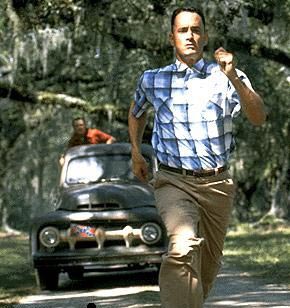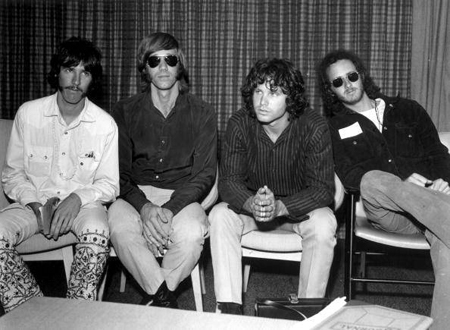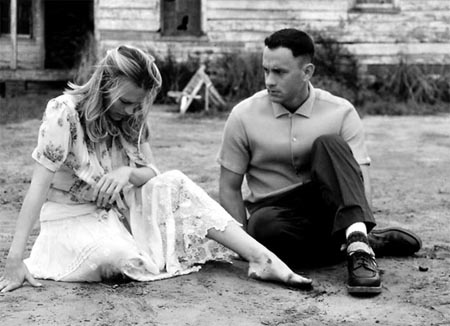Trying to Break on Through while Running on Empty
November 24, 2012 by Mike Czech
As a musician, fan, and teacher of popular music, I am interested in how songs are constructed both musically and lyrically to create a story that promotes a message from its author. Likewise, I am interested in how songs are used in a film to add to the messages that a film’s construction perpetuates. For this article, I will be attempting to do a cultural analysis of the 1994 film, Forrest Gump, through commenting on the inclusion and juxtaposition of popular songs with the images and plotlines in various scenes to show some of the socially unjust racial, gendered, and political messages that this piece of popular culture transmits.
Forrest Gump shows the life of a mentally challenged man from his childhood through adulthood during the decades of the 1950’s through the 1980’s. This time span was a very creative and eclectic time for popular music with its birth in the 1950’s in what was called Rock-n-Roll through the 1960’s as a form of protest with Folk and Psychedelic music and opening up in the 1970’s with different genres such as Progressive Rock, Punk, Reggae, Disco, New Wave and in the 1980’s with Heavy Metal and Hip-Hop. Though this film includes many examples of popular songs to help mark the progression of different time periods in Gump’s life, this is all they do since they are not discussed or problematized. And since many of these songs, which are deep with symbolic meaning, are used in haphazard, stereotypical, and non-contextual ways, it shows that not much thought was put into how these songs could have added much more depth to problematizing the many social issues that it shows happening during the course of history. If we see popular culture as a discursive system with competing narratives vying for power in its manipulated construction (Wang, 2000, p. 93), then this film does show that many of the narratives that are winning are those of white male heterosexuals or in other words, the establishment, as many of the song choices and their juxtapositions and lack of analysis seem to conclude.
One of first popular songs heard in the film is “Hound Dog,” sung by Elvis Presley, as he is seen performing it during his famous 1956 appearance on the Ed Sullivan show on a television in a department store window that Forrest and his mother glance at during their holiday shopping. What is interesting about the inclusion of this song is that it was one of the first songs that helped get Rock-n-Roll popularized in public consciousness since many people saw Elvis on television and reacted positively and negatively to his appearance, performance, and musical abilities. It also helped open space for Rock-n-Roll to be thought of as a white male heterosexual construction though this form of music was based on the Blues, Jazz, and Gospel created by African-Americans all the way back to the times of slavery when the “call and response” of coded language was sung as a way to transmit messages without the master knowing the meaning of them. Furthermore, the naming of the term “Rock-n-Roll” is given credit to Alan Freed who said it on his radio show in Cleveland, Ohio, which is where the Rock-n-Roll Hall of Fame is located. Though Freed is white, his naming of the words “rocking and rolling” comes from black musicians who had used these words many years before in the lyrics of various Blues songs to talk about a man being “rocked” or having had sex with a woman and then being “rolled” or taken for all of his money. The most popular version of the song “Hound Dog” is the Elvis version even though a black female, Big Mama Thornton, sang it before him. Thus, the film opens symbolically with a song that is a rip off of another version sung by a person of color by a white male heterosexual who did not write it. Furthermore, Elvis is scoffed at by Forrest’s mother as being too sexually suggestive and tells him to not watch it. This seems to suggest as Wang (2000) says in her analysis of Forrest Gump, that anyone who was seen as being rebellious and not conforming to an idealized family values conservative way that was mythologized in the 1950’s, was considered an outcast and usually shunned by other characters or shown in a negative or polarizing light (p. 97). It also seems to show that anyone who sang or played this “race music” as it was called back in the 1950’s was interpreted and objectified as someone who was very sexual, native, and in touch with the uncivilized and tribal way of being that came from not being a God-fearing Christian in the United States during this time period. Many record burnings and protests occurred in various parts of the country, mainly the South, as a way to assuage the fear of this rock-n-roll or “race music” corrupting the order of the white youth with the disorder and chaos of black sexuality. Interestingly, one of Gump’s ancestors is seen as belonging to the Ku Klux Klan, though nothing much is said about it other than it being a historical marker to show his family roots in the South (Heller, 2003, p.11).

The 1960’s are shown as being a time of social unrest and war in Forrest Gump. Gump goes to war, survives, and is seen taking part unwittingly in various social protests when he tries to see his childhood friend, Jenny. Jenny, who is shown as a troubled child, since it is inferred that she was sexually molested by her father, grows up to have a troubled life seeming to run away from her problems by never being able to settle down in one place and have a family, as it ends in her untimely death from contracting a disease that is not named though inferred that it was AIDS. She is the one who tells Forrest to run away from danger and she is the one who is always talking about flying away, which at one point she almost does in a suicide attempt on top of a tall building before coming to her senses after a cocaine and heroin binge. The most striking scene, though, takes place at a strip club where she is working after being kicked out of college for posing nude in a Playboy magazine. Instead of coming out on stage and starting to dance in front of a group of middle-aged white males, she walks out naked with an acoustic guitar strapped to her, sits down on a stool on the edge of the stage, and starts strumming the chords to Bob Dylan’s “Blowin’ in the Wind.” After singing about three lines of the song, the men in the audience start heckling her and basically want her to do her stripping routine, which they paid to see. The song abruptly ends with a scuffle as Forrest, who is there naively to see Jenny play a song, runs in to save her from the men who by now are drunk and falling over each other while Forrest carries her away to safety.
This scene has a lot going in it, but it is never explained or returned to since the movie keeps progressing in a forward linear motion without ever problematizing the events that are taking place as building off and influencing one another. But, if there were some space for analysis here, the movie shows that for a female to get ahead or even be heard in the world, she has to use her sexuality and body to do so. In a previous scene, Forrest’s mother has to sleep with the school principal so Forrest does not have to go to a school for mentally disadvantaged children. Jenny has to sell her body to a magazine as well as use it as a stripper and in future scenes, as a punching bag for men, if she ever wants to get ahead in life. But the irony of having to play Dylan’s “Blowin’ in the Wind” naked in front of drunk men symbolizes that the civil rights groups and protesters of the 1960’s never had a chance in sustaining their vision since the establishment, or the ones who were able to have their voices actualized in the discourse of laws and rules in this country, spoke the loudest without ever listening to the words of these civil rights groups and protesters. “Blowin’ in the Wind,” which was released in 1963, was the song that many consider the start of and anthem of the civil rights movement. Dylan is questioning the establishment and is asking what it will take and how long it will be for people to realize that everyone is equal, though the answer is already happening since the youth, or anti-establishment, are talking about solutions. This scene shows that females were not equal and that white heterosexual males called the shots since they controlled when, where, and how long this freedom/protest music would be played, as the answers to these social problems were going to be perpetually blowing in the wind without any solutions. Furthermore, Dylan’s 1968 song, “All Along the Watchtower” is heard in the movie as performed by Jimi Hendrix when Gump first arrives in Vietnam as a soldier. The lines, “There must be some way out of here said the joker to the thief. There’s too much confusion, I can’t get no relief” are heard which seems to signal that the optimism that change would be occurring in 1963 had turned into confusion and desperation by 1968 since many young adults were dying in the Vietnam War, another example of the establishment calling the shots and creating a situation that tore the country apart mentally, emotionally, and physically.
Another band that is prominent in the movie is The Doors since four of their songs are heard in different scenes. Though this band only put out five albums between 1967-1971 due to breaking up after the death of their lead singer and songwriter, Jim Morrison, from a drug induced heart attack at 27, their music was very influential in impacting and setting the stage for the 1970’s and its different genres of music such as Glam Rock, Punk Rock, New Wave, and Heavy Metal. Morrison did not write lyrics about peace and love like many of the Psychedelic bands were doing in the late 1960’s. He was singing about death, being an outcast, and trying to break through perceptual barriers by going on the shaman’s journey to bring back something meaningful to the crowd. His stage performances were legendary since they were totally improvisational and no one knew what he was going to do or sing or say. Many past films have used the band’s music to great effect to enhance meanings and messages since the words that Morrison wrote were very poetic, dark, and showed the confusion that Dylan was singing about in the sense of the social injustices that the country was trying to overcome but being divided through war and civil unrest. For example, Francis Ford Coppola used The Doors’ “The End” at the start of his movie, Apocalypse Now, to frame the descent into the heart of darkness and the futility that the Vietnam War opened.

Forrest Gump did not seem to use The Doors’ songs to enhance the meanings of the various scenes in which they were heard, as all four songs are wasted since they do not connect to these scenes dealing with what was happening in the war and what was happening to soldiers who returned home after the war. Gump sees his best friend Bubba die in his arms during the war and encounters many psychologically damaged and physically injured soldiers in the V.A. Hospital after the war. Only about 20 seconds of the beginning of “Soul Kitchen,” is heard while Gump is asked to look into a foxhole for enemy explosives while someone screams, “Fire in the hole!” as a grenade goes off. This song is about trying to stay in a state of mind expansion in the midst of a fast-paced world. If the last part of the song were played, one would hear the lines “Learn to forget,” repeated which might have been more appropriate for shedding light on what the soldiers tried to do to forget the horrors of war through taking drugs and becoming psychologically damaged. The next time we hear the band’s songs are after the war and Gump is in the V.A. Hospital while he is shown practicing and getting better at Ping-Pong, a game that he was told to play, which he unquestioningly does. Snippets of the songs, “Hello, I Love You,” “When Your Strange,” and “Break on Through (To the Other Side)” are heard in succession in a 30 second montage over Gump’s Ping-Pong excursion and that is it. If one looked deeper into these songs, one would see that many of the social issues that were being discussed at the end of the 1960’s are in these songs such as the sexual revolution, not conforming to societal or establishment ideals, and using different ways to open one’s perceptions to seeing more than one viewpoint. Thus, the Vietnam War as well as progressive social issues are glossed over (Heller, 2003, p. 11), taken as a historical moments in time, and not critically reflected on in the film, though the music that is included during this part of the movie could have opened space for dialogue that is used more adroitly. This point is also reiterated during the scene when Gump is asked to speak at the social protest march in Washington D.C. and when he does, his microphone is cut off by a member of the establishment, a war general, and no one can hear him.

Moreover, Forrest Gump shows the 1970’s as a time of sex and drugs, which seems to be what the country inherited after having lived through the various civil rights and social protest marches that the anti-establishment tried to use to move society away from the conservative ideals of the 1950’s. Thus, those who partook in this sex and drug lifestyle are shown getting in trouble and living depressing and vapid lives. The scene, though, that shows the most vapidity, is when Gump decides to go on a running spree to overcome his depression for Jenny leaving him again. Gump decides to run, like he has always done, only this time he doesn’t stop running for three years as he crosses the country a few times. Along the way he gets media attention and gains some people who follow him like he is a savior and await his words for guidance. Similar to the same reason he decided to run, he stops running because he feels like it. There is no meaning behind his running other than just doing it and his followers are flabbergasted when he tells them so (Heller, 2003, p. 11). Songs that are played during this running episode include “On the Road Again” (Willie Nelson), “Go Your Own Way” (Fleetwood Mac), “Against the Wind” (Bob Seeger), “It Keeps You Running” (Doobie Brothers), and “Running on Empty” (Jackson Browne). Though all of these songs were popular in the 1970’s, they tell stories of disillusionment ranging from not living up to one’s own ideals to not being able to see the social ideals of the 1960’s come to fruition. The most poignant song of the group, Jackson Browne’s, “Running on Empty,” tells the story of someone who is on his last leg after trying to keep the social ideals alive from the 1960’s during the narcissistic, capitalistic ventures of the “Me Generation” of the 1970’s. Again, this song is not problematized or shown in a way to shed light on this narcissism other than Gump’s stance, as what Heller (2003) sees as “the holy fool” or America’s “idiot hero” where this “…figure is appropriated to provide a lesson in the virtues of apolitical self-fashioning” (p. 11). As we have seen, this movie has the chance of providing insight into the history of the United States by trying to problematize the social and political upheavals of a turbulent time period, but because it is shown through the eyes of a protagonist who remains apolitical and noncritical, these issues are not discussed.
In conclusion, Forrest Gump could have been a movie that opened space for a critical discussion since the songs that were included were rich with meaning and could have been contextualized to show that there were many atrocities and social injustices committed against people of color, women, the youth of America who tried to overcome this oppression, and the overall actualization of white male heterosexual ideals in the public discourse. Interestingly, Forrest Gump was a movie that grossed close to $700,000,000 and won Academy Awards in the categories of Best Actor in a Leading Role, Best Director, Best Picture, Best Visual Effects, Best Film Editing, and Best Screenplay written from a previously published source. In essence, this was a popular movie in 1994, but it also seemed to be a call to look at the history of the United States as a lopsided power struggle where people were not able to sustain a communal effort to fight the establishment. Being able to critically analyze popular culture as a discursive system that promotes certain messages while being able to discuss this in the community and classrooms is the first step in trying to start a complicated conversation to look deeper into things and not blindly accept what is told to us. The goal is to not emulate Forrest Gump’s naiveté, but to look at it as a warning to what can happen if one does not critically reflect on the world.
References
Finerman, W., Newirth, C., Starkey, S., Tisch, S. (Producers), & Zemeckis, R. (Director). (1994). Forrest Gump [DVD]. New York: Paramount Pictures.
Heller, D. (2003). Holy fools, secular saints, and illiterate saviors in American literature and popular culture. Comparative Literature and Culture, 5(3/4), 1-15.
Wang, J. H. (2000). A struggle of contending stories: Race, gender, and political memory in "Forrest Gump." Cinema Journal, 39(3), 92-115.
Copyright 2012 by Somebody's Webpage







